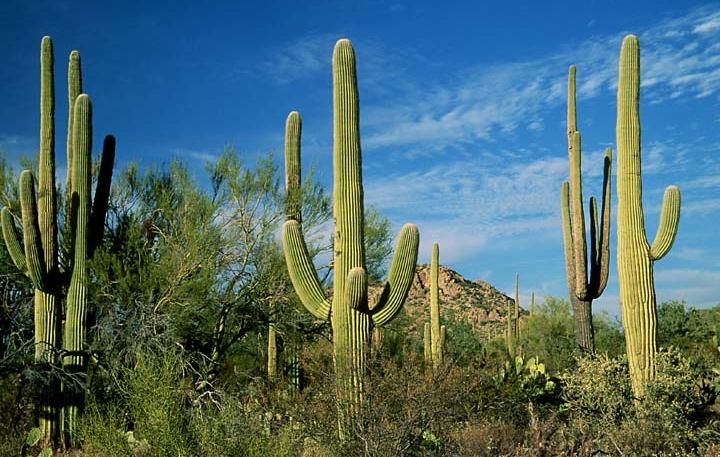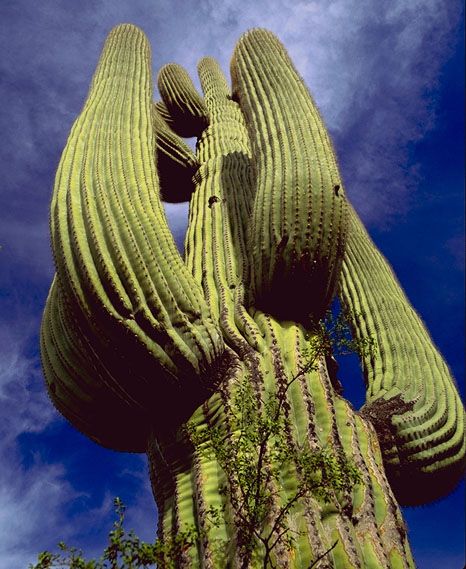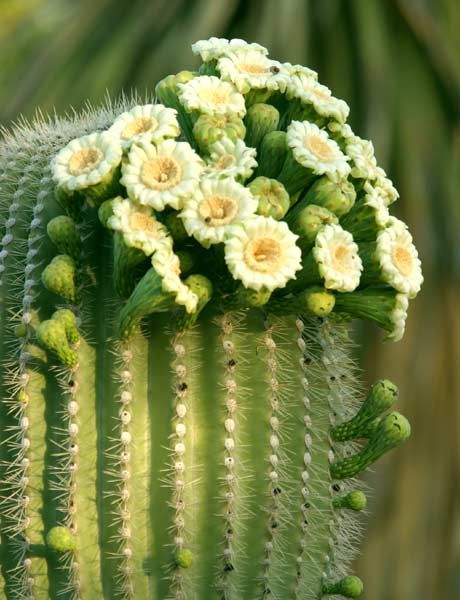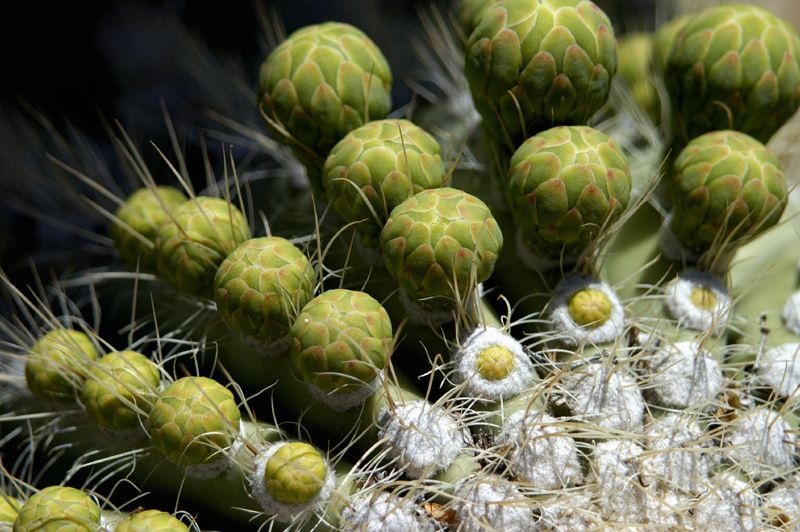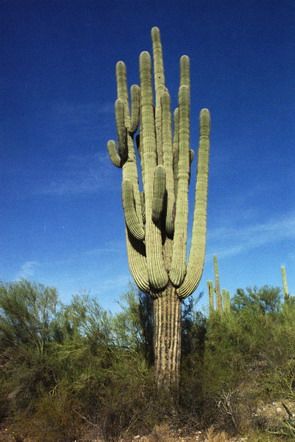Carnegiea gigantea
Common names: saguaro, sahuaro, giant cactus, pitahaya
Synonims: Cerceus giganteus Engelm
Family: Cactaceae
Description
Carnegiea is a monotypic genus. There are no subspecies, varieties, or forms. Saguaro (Carnegiea gigantea) occurs throughout most of the Sonoran Desert in Arizona, California, and Mexico. The magnificent Saguaro Cactus, the state flower of Arizona, is composed of a tall, thick, fluted, columnar stem, often with several large branches (arms) curving upward in the most distinctive conformation of all Southwestern cacti.
|
|
|
Habitat: Desert slopes and flats, especially rocky bajadas.
Saguaro is a native, arborescent, stem succulent that grows from 9.8 to 52.5 feet (3-16 m) tall and 5.9 to 29.5 inches (5-75 cm) in diameter. It is the largest of the columnar cacti growing in the United States. The skin is smooth and waxy, the trunk and stems have stout, 2-inch spines clustered on their ribs. When water is absorbed , the outer pulp of the Saguaro can expand like an accordion, increasing the diameter of the stem and, in this way, can increase its weight by up to a ton.
Saguaro has an incredible deep anchoring taproot (up to 3.2 feet [1 m] deep) and extensive lateral roots (13 to 98 feet [4-30 m] long); these roots wrap about rocks providing adequate anchorage from winds across the rocky bajadas. The stems are simple with one to five (rarely up to 49) lateral, erect branches. Saguaro trunks have many prominent ribs, armed with dense, stout spines that are up to 2.8 inches (7 cm) long.
The slow growth and great capacity of the Saguaro to store water allow it to flower every year, regardless of rainfall. Like most cactus, the buds appear on the southeastern exposure of stem tips, and flowers may completely encircle stems in a good year. The flowers are creamy-white with yellow centers, 3.4 to 4.9 inches (8.7-12.5 cm) long and occur at the ends of branches. They bloom from may to june; clustered near the ends of branches, the blossoms open during cooler desert nights and close again by next midday. Fruits are oblong and contain up to 2,500 seeds.
|
|
|
Life cycle
The Saguaro often begins life in the shelter of a "nurse" tree or shrub which can provide a shaded, moister habitat for the germination of life. The Saguaro grows very slowly -- perhaps an inch a year -- but to a great height, 15 to 50 feet. The largest plants, with more than 5 arms, are estimated to be 200 years old. An average old Saguaro would have 5 arms and be about 30 feet tall.
Care and cultivation
Temperatures below 23 degrees Fahrenheit (-5 deg C) will damage saguaro. Death will occur after exposure to below freezing temperatures for 29 or more consecutive hours. Fluctuations in saguaro numbers often are due to recurring catastrophic freezes.
Saguaro occurs on shallow soils that are light, coarse-textured, and rocky. The soils are underlain at 3.2 to 9.6 feet (1-3 m) depths by an impervious caliche layer. There is usually no differentiation f
the soil into horizons. Saguaro is found at elevations from 1,640 to 5,000 feet (500-1,525 m). Saguaro has been reported on all aspects. However, most individuals occur on open east- and west-facing slopes, and the fewest occur on north-facing slopes.
Propagation
Sexuall reproduction begins when a plant is approximately 7.2 feet (2.2 m) tall. Growth is extremely slow. At the end of 2 years, seedlings will be about 0.25 inch (0.6 cm) tall. At 3.2 feet (1 m), plants may be 20 to 50 years old.
Flowers only develop at branch and main stem tips. An increase in branch number increases the reproductive potential of an individual.
Many different animals pollinate the nocturnally blooming saguaro flowers and are detailed elsewhere. Flowers are open for less than 24 hours. A plant averages four open flowers per day for about 30 days. Plants commonly have more than 100 fruits.
Seeds germinate readily. Conditions for germination are detailed elsewhere. Saguaro seeds are short-lived; seed reserves are not maintained in the soil. In random soil samples, relative densities of saguaro seeds were between 0.3 and 2.0 percent. Less than 1 percent of the annual seed production germinates due to predation or moisture stress. Heavy seedfall can occur during the summer rains. Drought during the 12 to 14 months following germination is the most critical factor threatening seedling survival.
Perennial shrubs, such as foothills paloverde (Cercidium microphyllum), are important as nurse plants for facilitating saguaro establishment. Seed dispersal by frugivorous birds is a primary factor
in saguaro establishment beneath shrub canopies.
Pests and diseases
Saguaro are susceptible to few diseases. Healthy saguaro often wall off larvae tunnels, woodpecker holes, or other wounds. Some necroses may occur, however, after mechanical damage to saguaro from breakage, frost, or lightning. Insects, saprophytic yeasts, molds, and bacteria readily inhabit and breed in saguaro necroses.
Info:
- The flowers, fruits, and seeds of the saguaro are important food sources for wildlife;
- Saguaro provides nesting habitat for birds and small mammals. Saguaro mortality can have a high negative impact on bird species that use it for cover and nesting;
- Saguaros are slow growing, taking up to 75 years to develop a side shoot. Some specimens may live for more than 200 years; the champion saguaro grows in Maricopa County, Arizona and is 13.8 m tall and has a girth of 3.1 m;
- Saguaro is protected under the Arizona Native Plant Law. Cactus poaching is of concern around Saguaro National Monument and urban centers. Natural environmental extremes in temperature and drought, however, are more of a threat to the survival of this species.
Articole asemănătoare
-
Fittonia sau Planta Mozaic
Roz, verde sau rosu intens: planta mozaic are un aspect delicat, iar modelul frunzelor este foarte elegant si deosebit. Fiind o planta care provine din padurile tropicale, aceasta are nevoie de o umiditate
-
Trandafiri noi si vechi de gradina
Trandafirii, flori care exprima romantism si rafinament, au fost si vor fi in continuare la mare cautare, pentru a fi oferiti in dar persoanelor dragi, dar si pentru a completa peisajul unei gradini.
-
Parcul Dendrologic, Simeria
Conform Enciclopediei Britanice, Parcul Dendrologic de la Simeria, situat in judetul Hunedoara, Transilvania, este al treilea cel mai frumos parc din Europa. Acelasi loc il ocupa si dupa numarul de specii de arbori. La nivel mondial, Parcul Dendrologic de la Simeria ocupa locul unsprezece.
-
Plante de apartament - Vriesea splendens
Extrem de decorativa atat prin frunzis cat si prin flori, pretinde o ingrijire atenta si detaliata. Alaturi de umiditatea atmosferica ridicata, udarea reprezinta un factor cheie in ingrijirea acestei plante.
-
Fittonia
Este o planta mica ce se distinge prin pozitia taratoare a lastarilor si nervatiunea frunzei, colorata alb, roz, rosu, cu aspect de plasa.
